Behavioral Theory: Types of Conditioning, Advantages and Disadvantages
VerifiedAdded on 2023/04/24
|8
|2008
|470
AI Summary
The Behavioral Theory is a learning theory based on conditioning. It studies observable behaviors and ignores internal mental states. There are two types of conditioning: classical and operant. The theory has advantages such as rigorous experimental research methods and contributions to behavior shaping techniques. However, it also has disadvantages such as ignoring mental processes and biological factors. The theory was contributed to by Thorndike, Skinner, and Watson. Research questions include the benefits and limitations of the theory.
Contribute Materials
Your contribution can guide someone’s learning journey. Share your
documents today.
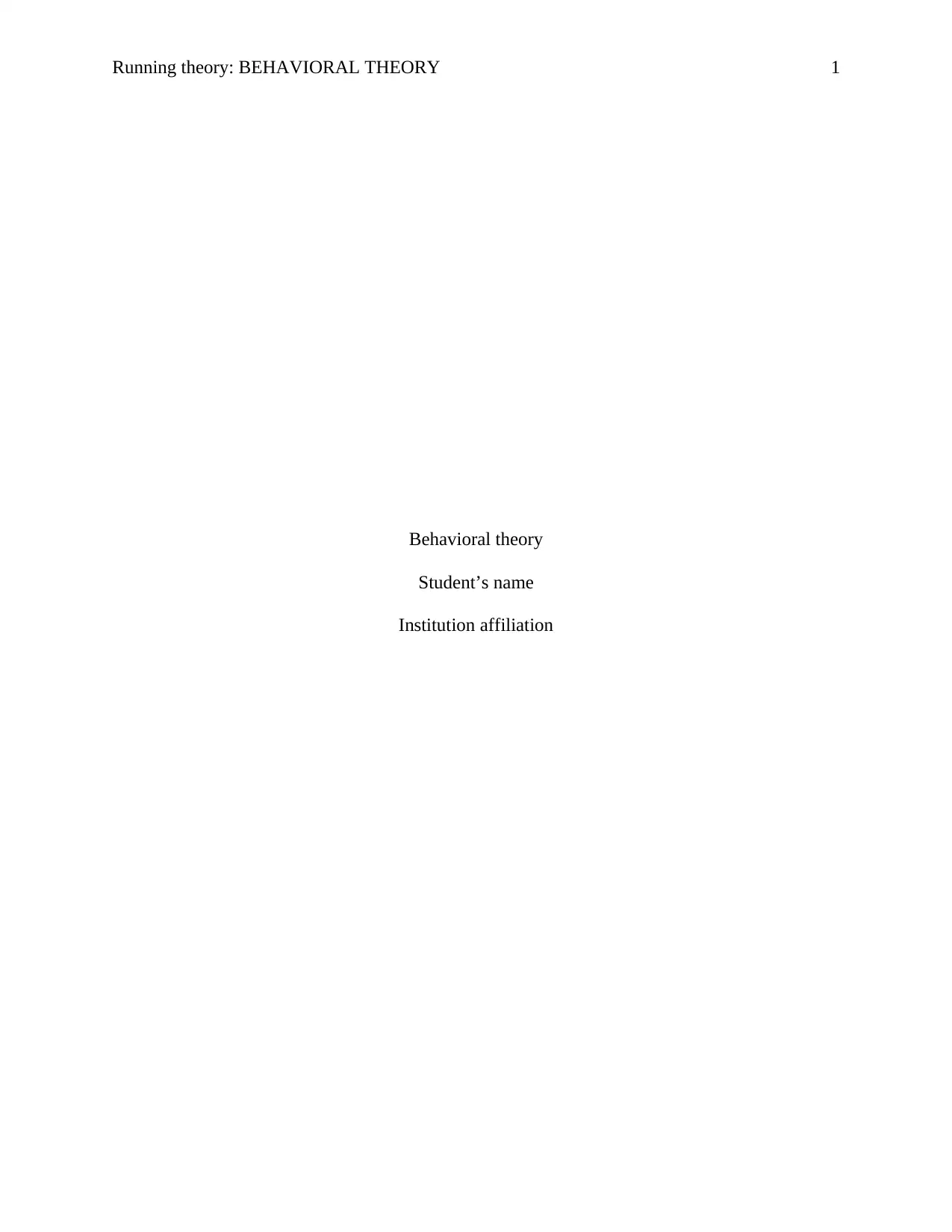
Running theory: BEHAVIORAL THEORY 1
Behavioral theory
Student’s name
Institution affiliation
Behavioral theory
Student’s name
Institution affiliation
Secure Best Marks with AI Grader
Need help grading? Try our AI Grader for instant feedback on your assignments.
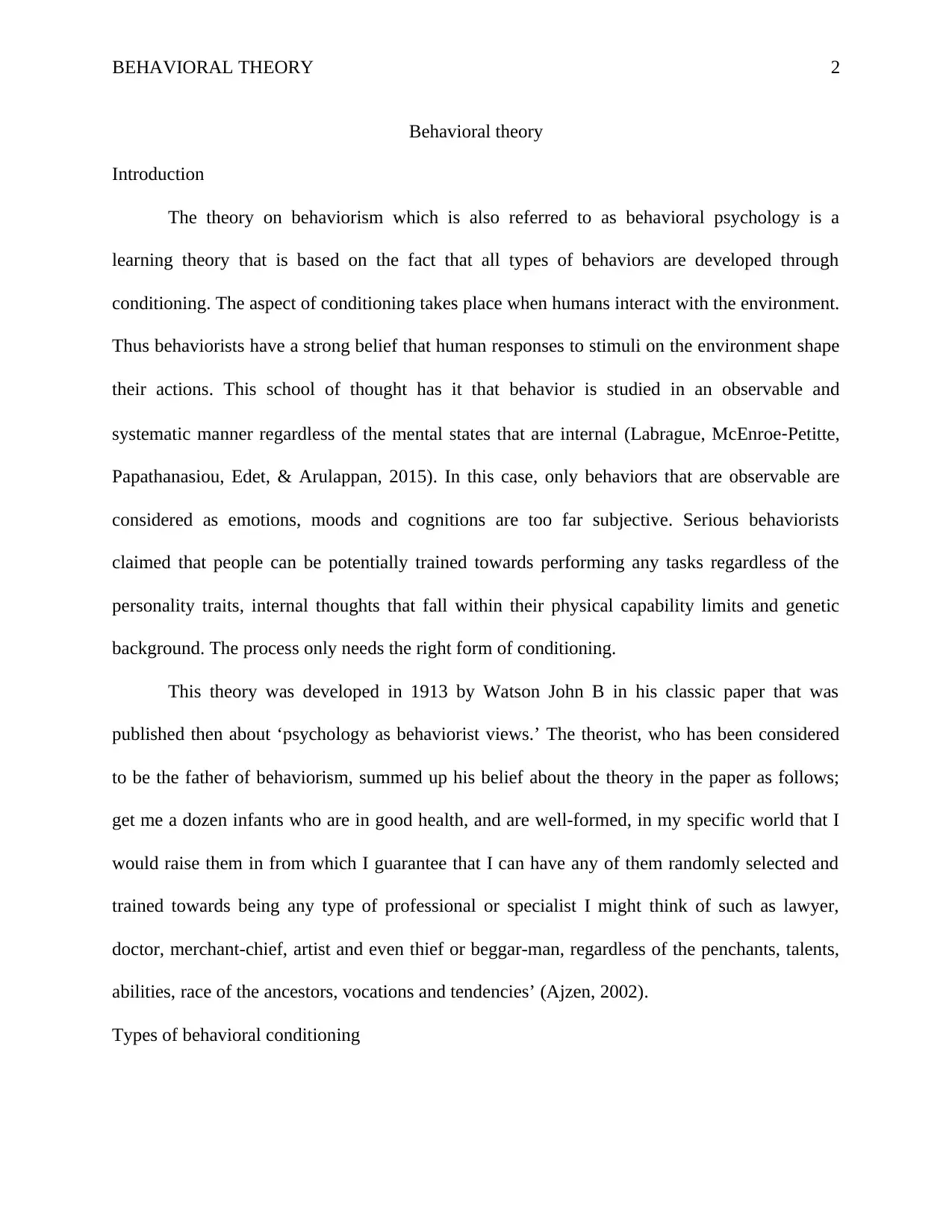
BEHAVIORAL THEORY 2
Behavioral theory
Introduction
The theory on behaviorism which is also referred to as behavioral psychology is a
learning theory that is based on the fact that all types of behaviors are developed through
conditioning. The aspect of conditioning takes place when humans interact with the environment.
Thus behaviorists have a strong belief that human responses to stimuli on the environment shape
their actions. This school of thought has it that behavior is studied in an observable and
systematic manner regardless of the mental states that are internal (Labrague, McEnroe‐Petitte,
Papathanasiou, Edet, & Arulappan, 2015). In this case, only behaviors that are observable are
considered as emotions, moods and cognitions are too far subjective. Serious behaviorists
claimed that people can be potentially trained towards performing any tasks regardless of the
personality traits, internal thoughts that fall within their physical capability limits and genetic
background. The process only needs the right form of conditioning.
This theory was developed in 1913 by Watson John B in his classic paper that was
published then about ‘psychology as behaviorist views.’ The theorist, who has been considered
to be the father of behaviorism, summed up his belief about the theory in the paper as follows;
get me a dozen infants who are in good health, and are well-formed, in my specific world that I
would raise them in from which I guarantee that I can have any of them randomly selected and
trained towards being any type of professional or specialist I might think of such as lawyer,
doctor, merchant-chief, artist and even thief or beggar-man, regardless of the penchants, talents,
abilities, race of the ancestors, vocations and tendencies’ (Ajzen, 2002).
Types of behavioral conditioning
Behavioral theory
Introduction
The theory on behaviorism which is also referred to as behavioral psychology is a
learning theory that is based on the fact that all types of behaviors are developed through
conditioning. The aspect of conditioning takes place when humans interact with the environment.
Thus behaviorists have a strong belief that human responses to stimuli on the environment shape
their actions. This school of thought has it that behavior is studied in an observable and
systematic manner regardless of the mental states that are internal (Labrague, McEnroe‐Petitte,
Papathanasiou, Edet, & Arulappan, 2015). In this case, only behaviors that are observable are
considered as emotions, moods and cognitions are too far subjective. Serious behaviorists
claimed that people can be potentially trained towards performing any tasks regardless of the
personality traits, internal thoughts that fall within their physical capability limits and genetic
background. The process only needs the right form of conditioning.
This theory was developed in 1913 by Watson John B in his classic paper that was
published then about ‘psychology as behaviorist views.’ The theorist, who has been considered
to be the father of behaviorism, summed up his belief about the theory in the paper as follows;
get me a dozen infants who are in good health, and are well-formed, in my specific world that I
would raise them in from which I guarantee that I can have any of them randomly selected and
trained towards being any type of professional or specialist I might think of such as lawyer,
doctor, merchant-chief, artist and even thief or beggar-man, regardless of the penchants, talents,
abilities, race of the ancestors, vocations and tendencies’ (Ajzen, 2002).
Types of behavioral conditioning
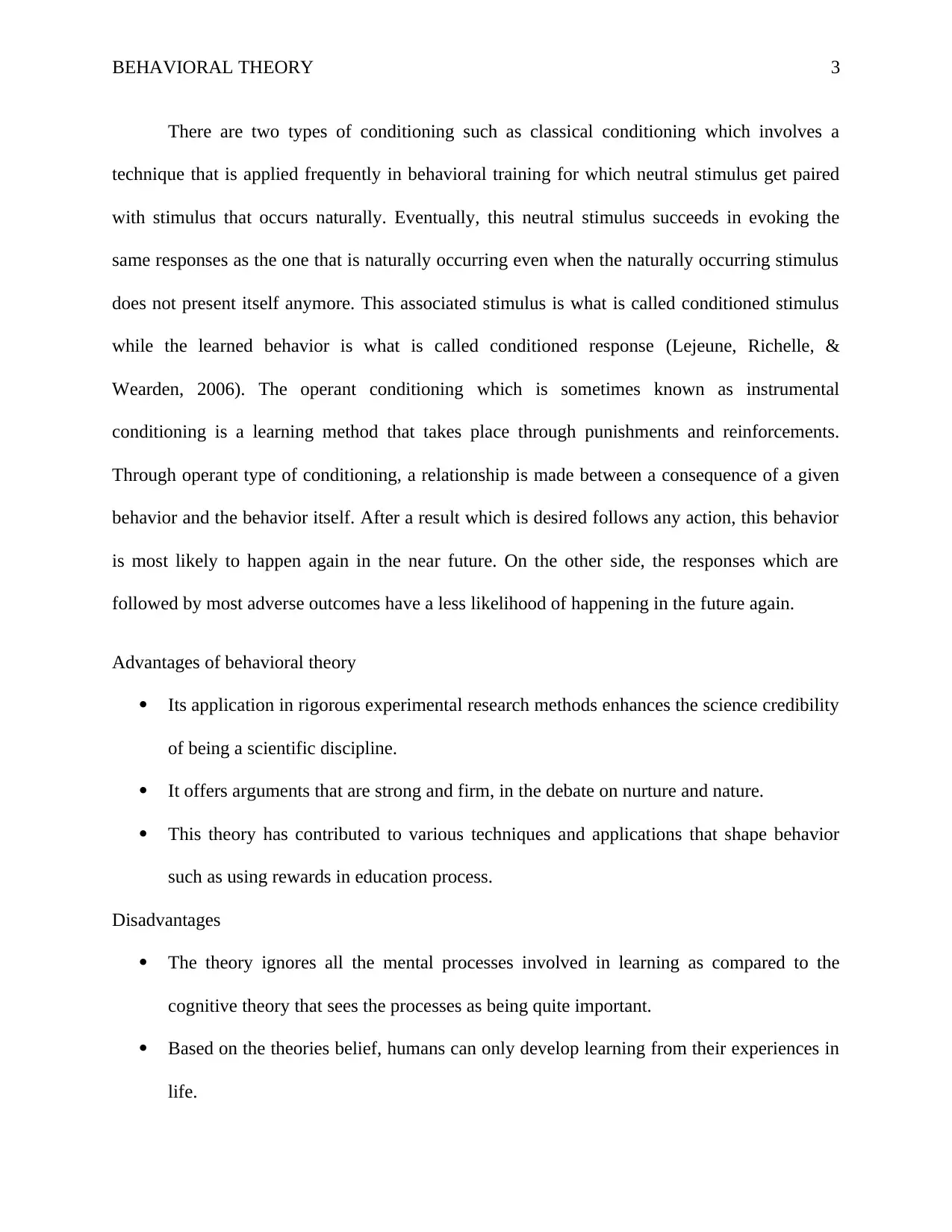
BEHAVIORAL THEORY 3
There are two types of conditioning such as classical conditioning which involves a
technique that is applied frequently in behavioral training for which neutral stimulus get paired
with stimulus that occurs naturally. Eventually, this neutral stimulus succeeds in evoking the
same responses as the one that is naturally occurring even when the naturally occurring stimulus
does not present itself anymore. This associated stimulus is what is called conditioned stimulus
while the learned behavior is what is called conditioned response (Lejeune, Richelle, &
Wearden, 2006). The operant conditioning which is sometimes known as instrumental
conditioning is a learning method that takes place through punishments and reinforcements.
Through operant type of conditioning, a relationship is made between a consequence of a given
behavior and the behavior itself. After a result which is desired follows any action, this behavior
is most likely to happen again in the near future. On the other side, the responses which are
followed by most adverse outcomes have a less likelihood of happening in the future again.
Advantages of behavioral theory
Its application in rigorous experimental research methods enhances the science credibility
of being a scientific discipline.
It offers arguments that are strong and firm, in the debate on nurture and nature.
This theory has contributed to various techniques and applications that shape behavior
such as using rewards in education process.
Disadvantages
The theory ignores all the mental processes involved in learning as compared to the
cognitive theory that sees the processes as being quite important.
Based on the theories belief, humans can only develop learning from their experiences in
life.
There are two types of conditioning such as classical conditioning which involves a
technique that is applied frequently in behavioral training for which neutral stimulus get paired
with stimulus that occurs naturally. Eventually, this neutral stimulus succeeds in evoking the
same responses as the one that is naturally occurring even when the naturally occurring stimulus
does not present itself anymore. This associated stimulus is what is called conditioned stimulus
while the learned behavior is what is called conditioned response (Lejeune, Richelle, &
Wearden, 2006). The operant conditioning which is sometimes known as instrumental
conditioning is a learning method that takes place through punishments and reinforcements.
Through operant type of conditioning, a relationship is made between a consequence of a given
behavior and the behavior itself. After a result which is desired follows any action, this behavior
is most likely to happen again in the near future. On the other side, the responses which are
followed by most adverse outcomes have a less likelihood of happening in the future again.
Advantages of behavioral theory
Its application in rigorous experimental research methods enhances the science credibility
of being a scientific discipline.
It offers arguments that are strong and firm, in the debate on nurture and nature.
This theory has contributed to various techniques and applications that shape behavior
such as using rewards in education process.
Disadvantages
The theory ignores all the mental processes involved in learning as compared to the
cognitive theory that sees the processes as being quite important.
Based on the theories belief, humans can only develop learning from their experiences in
life.
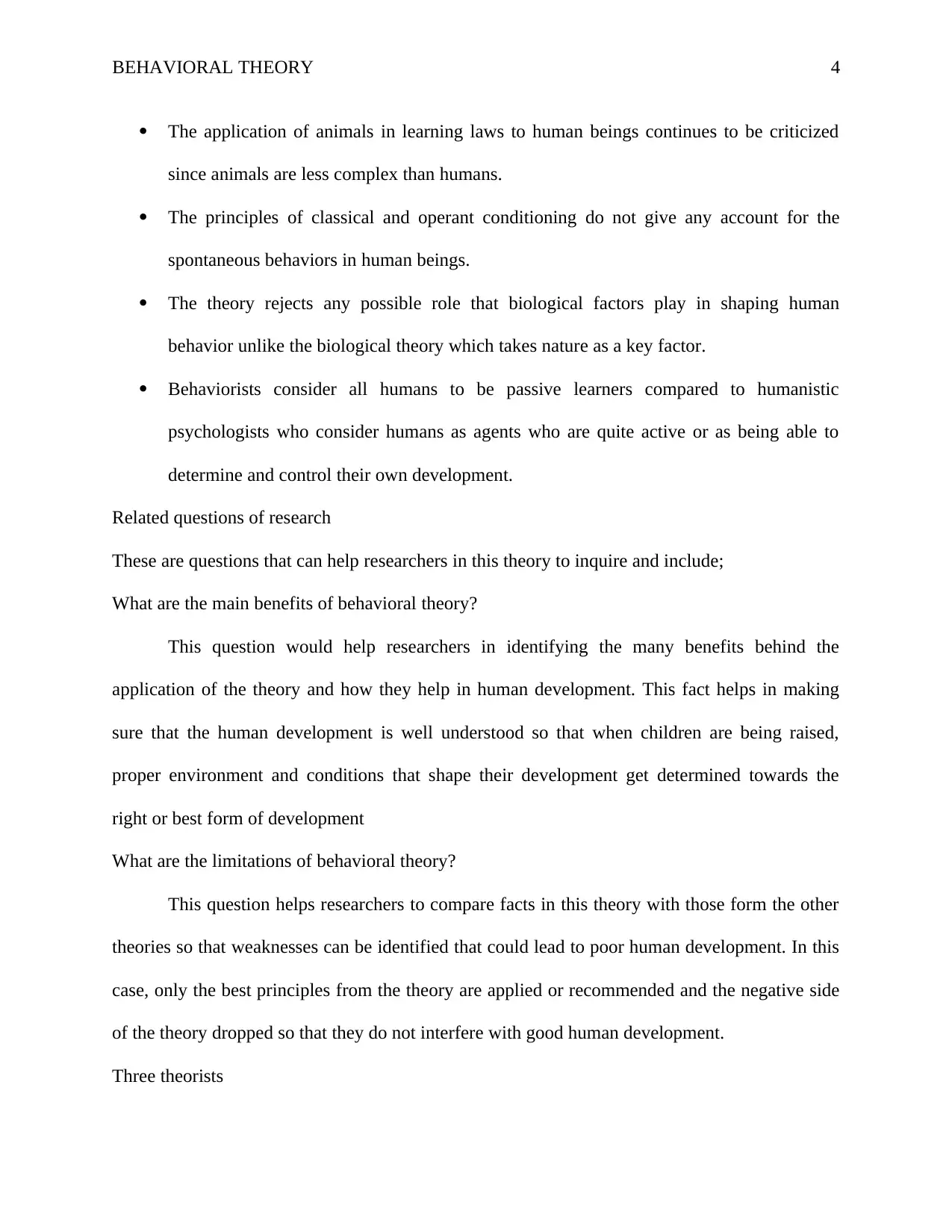
BEHAVIORAL THEORY 4
The application of animals in learning laws to human beings continues to be criticized
since animals are less complex than humans.
The principles of classical and operant conditioning do not give any account for the
spontaneous behaviors in human beings.
The theory rejects any possible role that biological factors play in shaping human
behavior unlike the biological theory which takes nature as a key factor.
Behaviorists consider all humans to be passive learners compared to humanistic
psychologists who consider humans as agents who are quite active or as being able to
determine and control their own development.
Related questions of research
These are questions that can help researchers in this theory to inquire and include;
What are the main benefits of behavioral theory?
This question would help researchers in identifying the many benefits behind the
application of the theory and how they help in human development. This fact helps in making
sure that the human development is well understood so that when children are being raised,
proper environment and conditions that shape their development get determined towards the
right or best form of development
What are the limitations of behavioral theory?
This question helps researchers to compare facts in this theory with those form the other
theories so that weaknesses can be identified that could lead to poor human development. In this
case, only the best principles from the theory are applied or recommended and the negative side
of the theory dropped so that they do not interfere with good human development.
Three theorists
The application of animals in learning laws to human beings continues to be criticized
since animals are less complex than humans.
The principles of classical and operant conditioning do not give any account for the
spontaneous behaviors in human beings.
The theory rejects any possible role that biological factors play in shaping human
behavior unlike the biological theory which takes nature as a key factor.
Behaviorists consider all humans to be passive learners compared to humanistic
psychologists who consider humans as agents who are quite active or as being able to
determine and control their own development.
Related questions of research
These are questions that can help researchers in this theory to inquire and include;
What are the main benefits of behavioral theory?
This question would help researchers in identifying the many benefits behind the
application of the theory and how they help in human development. This fact helps in making
sure that the human development is well understood so that when children are being raised,
proper environment and conditions that shape their development get determined towards the
right or best form of development
What are the limitations of behavioral theory?
This question helps researchers to compare facts in this theory with those form the other
theories so that weaknesses can be identified that could lead to poor human development. In this
case, only the best principles from the theory are applied or recommended and the negative side
of the theory dropped so that they do not interfere with good human development.
Three theorists
Secure Best Marks with AI Grader
Need help grading? Try our AI Grader for instant feedback on your assignments.
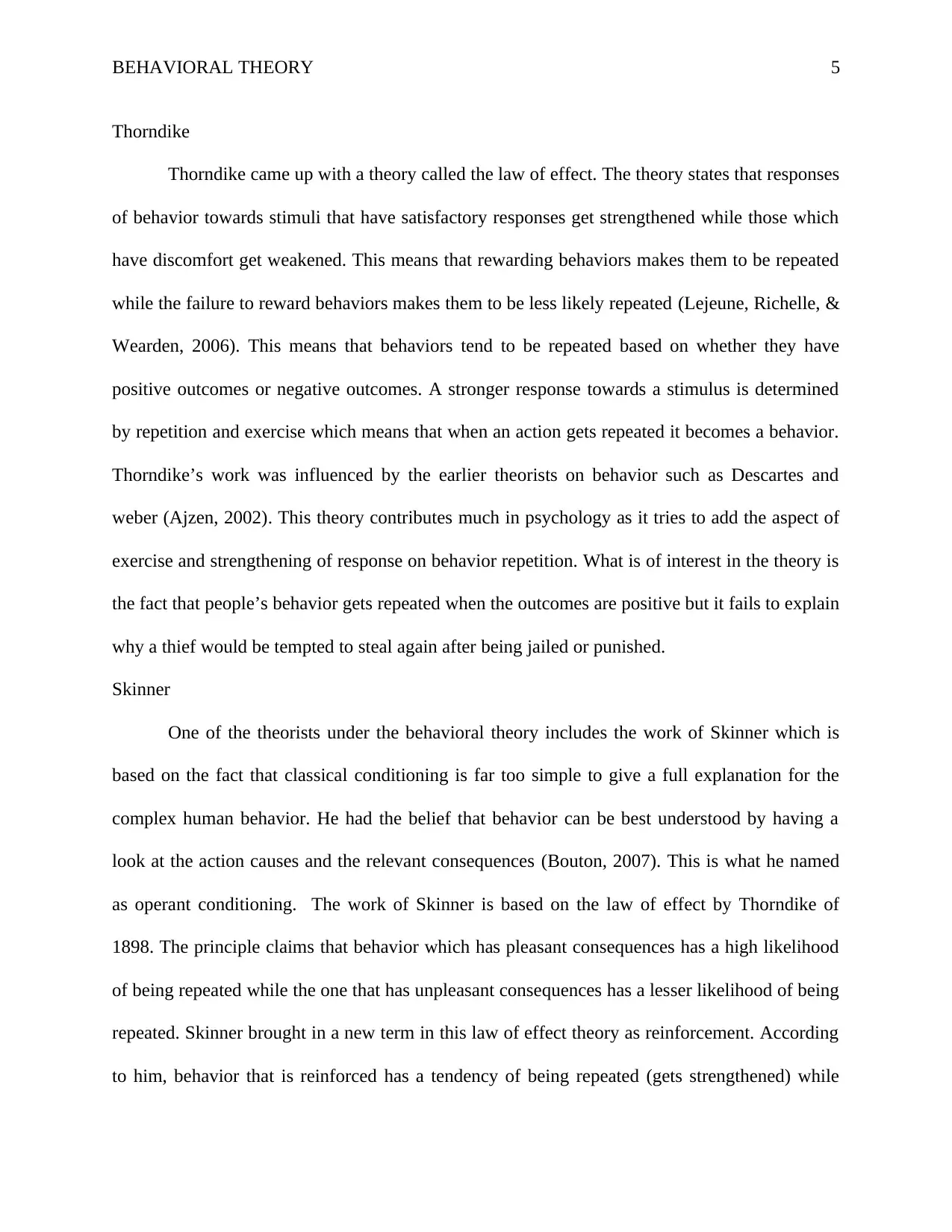
BEHAVIORAL THEORY 5
Thorndike
Thorndike came up with a theory called the law of effect. The theory states that responses
of behavior towards stimuli that have satisfactory responses get strengthened while those which
have discomfort get weakened. This means that rewarding behaviors makes them to be repeated
while the failure to reward behaviors makes them to be less likely repeated (Lejeune, Richelle, &
Wearden, 2006). This means that behaviors tend to be repeated based on whether they have
positive outcomes or negative outcomes. A stronger response towards a stimulus is determined
by repetition and exercise which means that when an action gets repeated it becomes a behavior.
Thorndike’s work was influenced by the earlier theorists on behavior such as Descartes and
weber (Ajzen, 2002). This theory contributes much in psychology as it tries to add the aspect of
exercise and strengthening of response on behavior repetition. What is of interest in the theory is
the fact that people’s behavior gets repeated when the outcomes are positive but it fails to explain
why a thief would be tempted to steal again after being jailed or punished.
Skinner
One of the theorists under the behavioral theory includes the work of Skinner which is
based on the fact that classical conditioning is far too simple to give a full explanation for the
complex human behavior. He had the belief that behavior can be best understood by having a
look at the action causes and the relevant consequences (Bouton, 2007). This is what he named
as operant conditioning. The work of Skinner is based on the law of effect by Thorndike of
1898. The principle claims that behavior which has pleasant consequences has a high likelihood
of being repeated while the one that has unpleasant consequences has a lesser likelihood of being
repeated. Skinner brought in a new term in this law of effect theory as reinforcement. According
to him, behavior that is reinforced has a tendency of being repeated (gets strengthened) while
Thorndike
Thorndike came up with a theory called the law of effect. The theory states that responses
of behavior towards stimuli that have satisfactory responses get strengthened while those which
have discomfort get weakened. This means that rewarding behaviors makes them to be repeated
while the failure to reward behaviors makes them to be less likely repeated (Lejeune, Richelle, &
Wearden, 2006). This means that behaviors tend to be repeated based on whether they have
positive outcomes or negative outcomes. A stronger response towards a stimulus is determined
by repetition and exercise which means that when an action gets repeated it becomes a behavior.
Thorndike’s work was influenced by the earlier theorists on behavior such as Descartes and
weber (Ajzen, 2002). This theory contributes much in psychology as it tries to add the aspect of
exercise and strengthening of response on behavior repetition. What is of interest in the theory is
the fact that people’s behavior gets repeated when the outcomes are positive but it fails to explain
why a thief would be tempted to steal again after being jailed or punished.
Skinner
One of the theorists under the behavioral theory includes the work of Skinner which is
based on the fact that classical conditioning is far too simple to give a full explanation for the
complex human behavior. He had the belief that behavior can be best understood by having a
look at the action causes and the relevant consequences (Bouton, 2007). This is what he named
as operant conditioning. The work of Skinner is based on the law of effect by Thorndike of
1898. The principle claims that behavior which has pleasant consequences has a high likelihood
of being repeated while the one that has unpleasant consequences has a lesser likelihood of being
repeated. Skinner brought in a new term in this law of effect theory as reinforcement. According
to him, behavior that is reinforced has a tendency of being repeated (gets strengthened) while
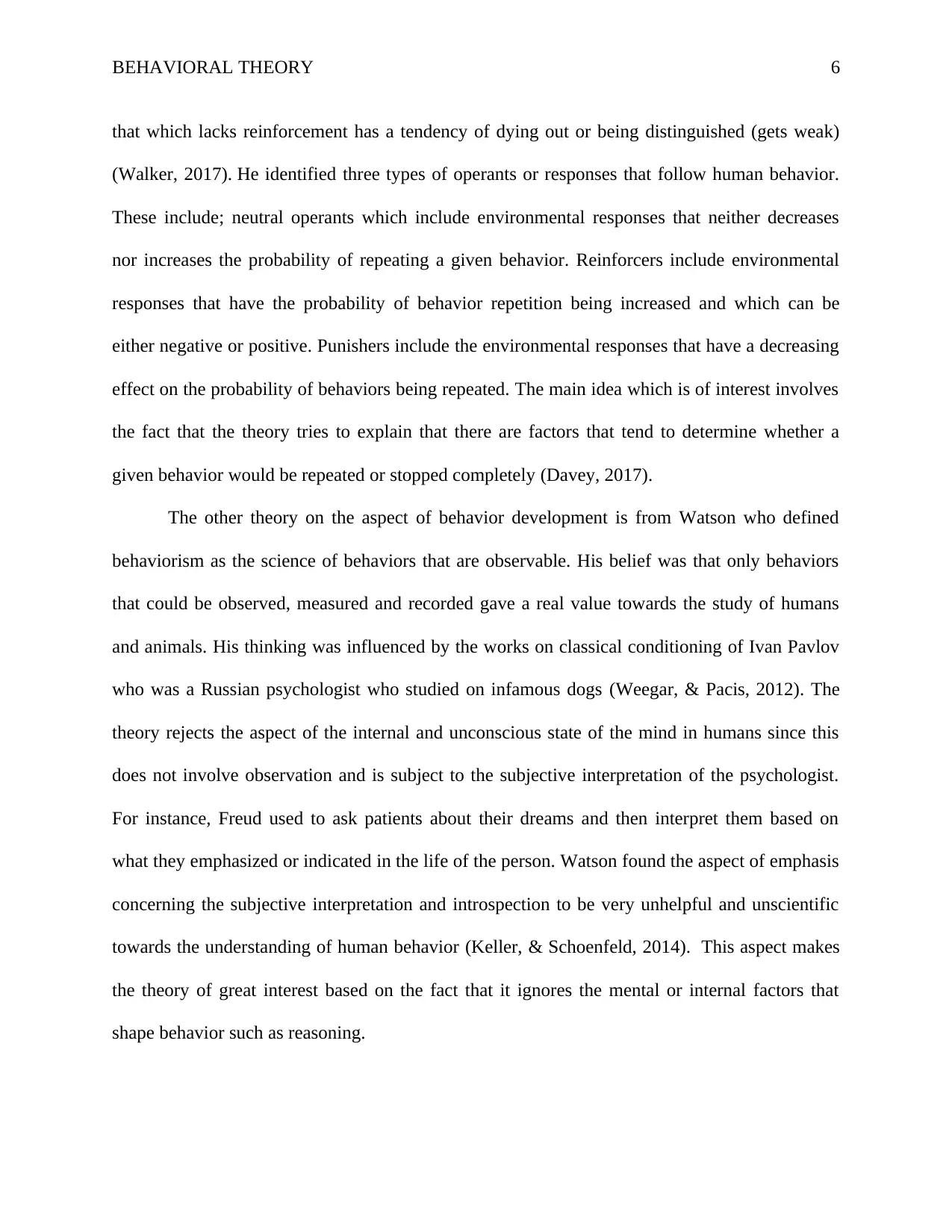
BEHAVIORAL THEORY 6
that which lacks reinforcement has a tendency of dying out or being distinguished (gets weak)
(Walker, 2017). He identified three types of operants or responses that follow human behavior.
These include; neutral operants which include environmental responses that neither decreases
nor increases the probability of repeating a given behavior. Reinforcers include environmental
responses that have the probability of behavior repetition being increased and which can be
either negative or positive. Punishers include the environmental responses that have a decreasing
effect on the probability of behaviors being repeated. The main idea which is of interest involves
the fact that the theory tries to explain that there are factors that tend to determine whether a
given behavior would be repeated or stopped completely (Davey, 2017).
The other theory on the aspect of behavior development is from Watson who defined
behaviorism as the science of behaviors that are observable. His belief was that only behaviors
that could be observed, measured and recorded gave a real value towards the study of humans
and animals. His thinking was influenced by the works on classical conditioning of Ivan Pavlov
who was a Russian psychologist who studied on infamous dogs (Weegar, & Pacis, 2012). The
theory rejects the aspect of the internal and unconscious state of the mind in humans since this
does not involve observation and is subject to the subjective interpretation of the psychologist.
For instance, Freud used to ask patients about their dreams and then interpret them based on
what they emphasized or indicated in the life of the person. Watson found the aspect of emphasis
concerning the subjective interpretation and introspection to be very unhelpful and unscientific
towards the understanding of human behavior (Keller, & Schoenfeld, 2014). This aspect makes
the theory of great interest based on the fact that it ignores the mental or internal factors that
shape behavior such as reasoning.
that which lacks reinforcement has a tendency of dying out or being distinguished (gets weak)
(Walker, 2017). He identified three types of operants or responses that follow human behavior.
These include; neutral operants which include environmental responses that neither decreases
nor increases the probability of repeating a given behavior. Reinforcers include environmental
responses that have the probability of behavior repetition being increased and which can be
either negative or positive. Punishers include the environmental responses that have a decreasing
effect on the probability of behaviors being repeated. The main idea which is of interest involves
the fact that the theory tries to explain that there are factors that tend to determine whether a
given behavior would be repeated or stopped completely (Davey, 2017).
The other theory on the aspect of behavior development is from Watson who defined
behaviorism as the science of behaviors that are observable. His belief was that only behaviors
that could be observed, measured and recorded gave a real value towards the study of humans
and animals. His thinking was influenced by the works on classical conditioning of Ivan Pavlov
who was a Russian psychologist who studied on infamous dogs (Weegar, & Pacis, 2012). The
theory rejects the aspect of the internal and unconscious state of the mind in humans since this
does not involve observation and is subject to the subjective interpretation of the psychologist.
For instance, Freud used to ask patients about their dreams and then interpret them based on
what they emphasized or indicated in the life of the person. Watson found the aspect of emphasis
concerning the subjective interpretation and introspection to be very unhelpful and unscientific
towards the understanding of human behavior (Keller, & Schoenfeld, 2014). This aspect makes
the theory of great interest based on the fact that it ignores the mental or internal factors that
shape behavior such as reasoning.
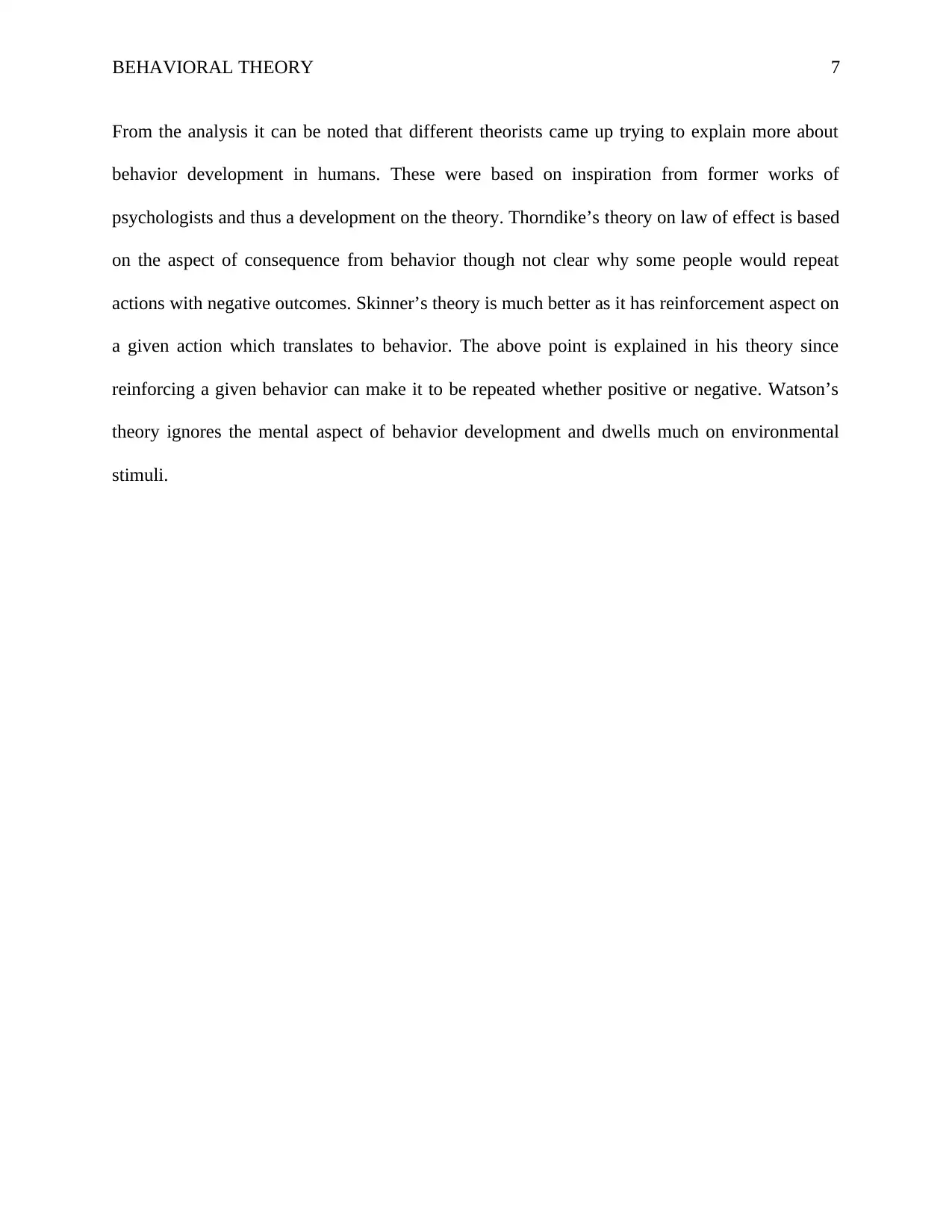
BEHAVIORAL THEORY 7
From the analysis it can be noted that different theorists came up trying to explain more about
behavior development in humans. These were based on inspiration from former works of
psychologists and thus a development on the theory. Thorndike’s theory on law of effect is based
on the aspect of consequence from behavior though not clear why some people would repeat
actions with negative outcomes. Skinner’s theory is much better as it has reinforcement aspect on
a given action which translates to behavior. The above point is explained in his theory since
reinforcing a given behavior can make it to be repeated whether positive or negative. Watson’s
theory ignores the mental aspect of behavior development and dwells much on environmental
stimuli.
From the analysis it can be noted that different theorists came up trying to explain more about
behavior development in humans. These were based on inspiration from former works of
psychologists and thus a development on the theory. Thorndike’s theory on law of effect is based
on the aspect of consequence from behavior though not clear why some people would repeat
actions with negative outcomes. Skinner’s theory is much better as it has reinforcement aspect on
a given action which translates to behavior. The above point is explained in his theory since
reinforcing a given behavior can make it to be repeated whether positive or negative. Watson’s
theory ignores the mental aspect of behavior development and dwells much on environmental
stimuli.
Paraphrase This Document
Need a fresh take? Get an instant paraphrase of this document with our AI Paraphraser
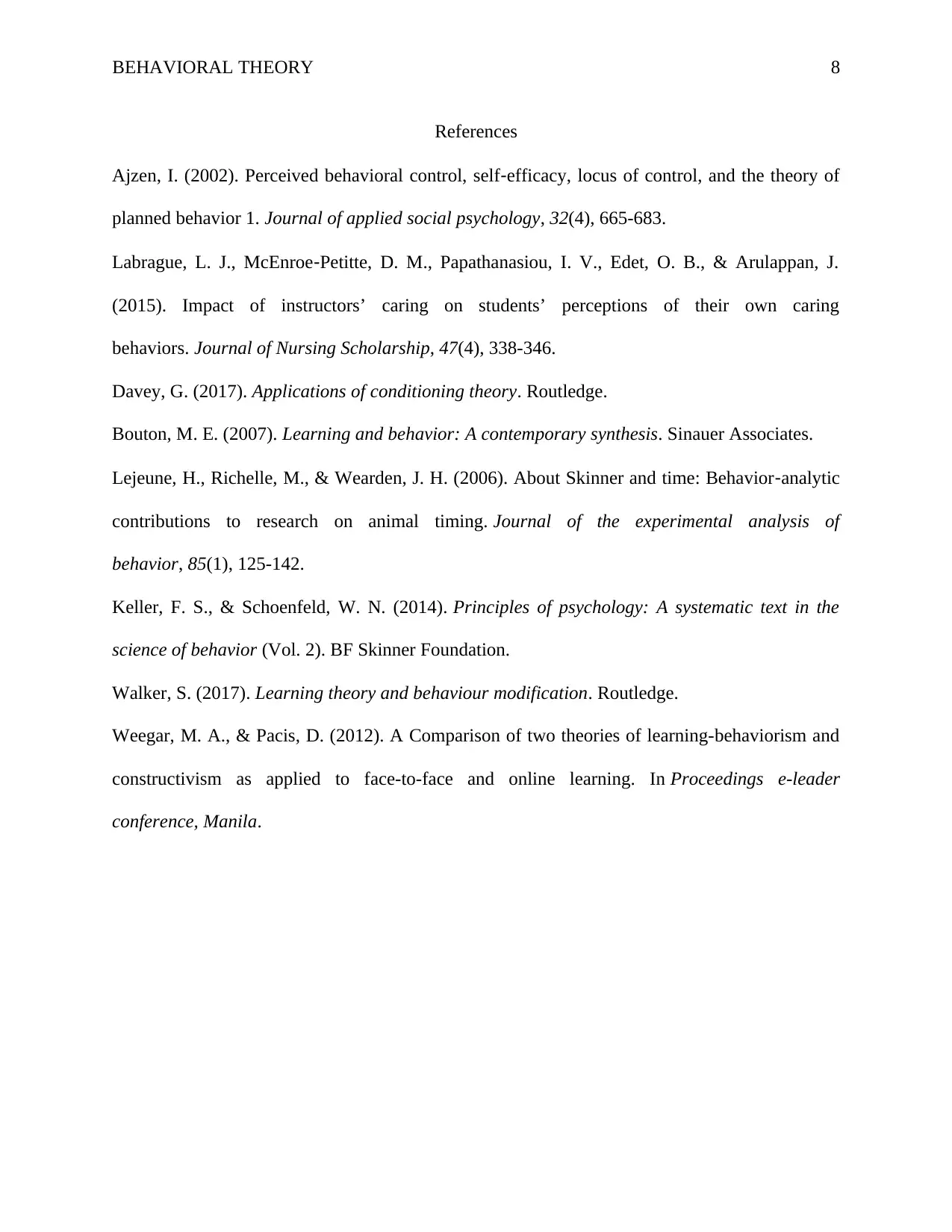
BEHAVIORAL THEORY 8
References
Ajzen, I. (2002). Perceived behavioral control, self‐efficacy, locus of control, and the theory of
planned behavior 1. Journal of applied social psychology, 32(4), 665-683.
Labrague, L. J., McEnroe‐Petitte, D. M., Papathanasiou, I. V., Edet, O. B., & Arulappan, J.
(2015). Impact of instructors’ caring on students’ perceptions of their own caring
behaviors. Journal of Nursing Scholarship, 47(4), 338-346.
Davey, G. (2017). Applications of conditioning theory. Routledge.
Bouton, M. E. (2007). Learning and behavior: A contemporary synthesis. Sinauer Associates.
Lejeune, H., Richelle, M., & Wearden, J. H. (2006). About Skinner and time: Behavior‐analytic
contributions to research on animal timing. Journal of the experimental analysis of
behavior, 85(1), 125-142.
Keller, F. S., & Schoenfeld, W. N. (2014). Principles of psychology: A systematic text in the
science of behavior (Vol. 2). BF Skinner Foundation.
Walker, S. (2017). Learning theory and behaviour modification. Routledge.
Weegar, M. A., & Pacis, D. (2012). A Comparison of two theories of learning-behaviorism and
constructivism as applied to face-to-face and online learning. In Proceedings e-leader
conference, Manila.
References
Ajzen, I. (2002). Perceived behavioral control, self‐efficacy, locus of control, and the theory of
planned behavior 1. Journal of applied social psychology, 32(4), 665-683.
Labrague, L. J., McEnroe‐Petitte, D. M., Papathanasiou, I. V., Edet, O. B., & Arulappan, J.
(2015). Impact of instructors’ caring on students’ perceptions of their own caring
behaviors. Journal of Nursing Scholarship, 47(4), 338-346.
Davey, G. (2017). Applications of conditioning theory. Routledge.
Bouton, M. E. (2007). Learning and behavior: A contemporary synthesis. Sinauer Associates.
Lejeune, H., Richelle, M., & Wearden, J. H. (2006). About Skinner and time: Behavior‐analytic
contributions to research on animal timing. Journal of the experimental analysis of
behavior, 85(1), 125-142.
Keller, F. S., & Schoenfeld, W. N. (2014). Principles of psychology: A systematic text in the
science of behavior (Vol. 2). BF Skinner Foundation.
Walker, S. (2017). Learning theory and behaviour modification. Routledge.
Weegar, M. A., & Pacis, D. (2012). A Comparison of two theories of learning-behaviorism and
constructivism as applied to face-to-face and online learning. In Proceedings e-leader
conference, Manila.
1 out of 8
Related Documents
Your All-in-One AI-Powered Toolkit for Academic Success.
+13062052269
info@desklib.com
Available 24*7 on WhatsApp / Email
![[object Object]](/_next/static/media/star-bottom.7253800d.svg)
Unlock your academic potential
© 2024 | Zucol Services PVT LTD | All rights reserved.





